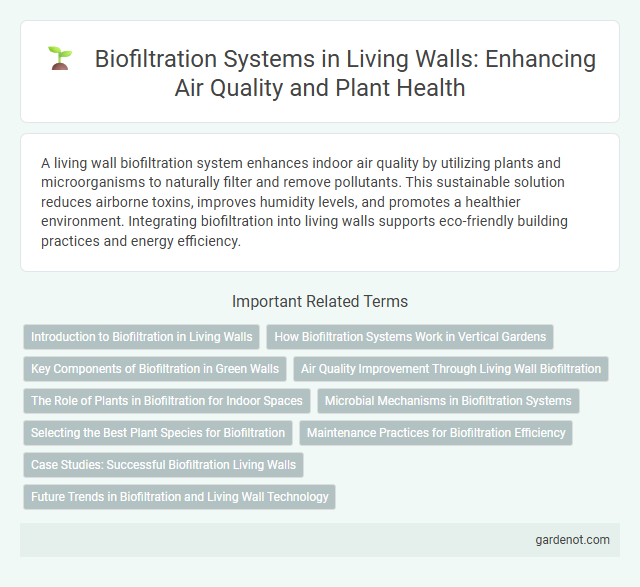A living wall biofiltration system enhances indoor air quality by utilizing plants and microorganisms to naturally filter and remove pollutants. This sustainable solution reduces airborne toxins, improves humidity levels, and promotes a healthier environment. Integrating biofiltration into living walls supports eco-friendly building practices and energy efficiency.
Introduction to Biofiltration in Living Walls
Biofiltration systems in living walls utilize natural processes to filter and purify air and water through vegetation and microbial activity. These systems enhance urban air quality by removing pollutants such as volatile organic compounds and particulate matter. Integrating biofiltration in living walls supports sustainable building design while promoting healthier indoor and outdoor environments.
How Biofiltration Systems Work in Vertical Gardens
Biofiltration systems in vertical gardens utilize layers of soil, plants, and microorganisms to filter and purify air and water. The plant roots absorb pollutants and excess nutrients while beneficial microbes break down contaminants, enhancing air quality and water runoff management. This natural filtration process improves indoor environments by reducing harmful substances and promoting healthier ecosystems within urban spaces.
Key Components of Biofiltration in Green Walls
Key components of biofiltration systems in living walls include a growth medium designed for optimal water retention and pollutant absorption, specialized plants selected for their high transpiration and contaminant uptake capabilities, and an integrated irrigation system that ensures consistent moisture levels and nutrient delivery. The substrates often consist of lightweight, porous materials such as expanded clay or coconut coir, which facilitate microbial activity essential for breaking down airborne toxins. Advanced biofiltration systems also incorporate sensors to monitor humidity, temperature, and pollutant concentration, optimizing plant health and filtration efficiency.
Air Quality Improvement Through Living Wall Biofiltration
Living wall biofiltration systems significantly enhance indoor air quality by utilizing plants and their root-associated microbes to absorb airborne pollutants such as volatile organic compounds (VOCs), particulate matter, and carbon dioxide. These living walls increase oxygen levels and reduce harmful toxins, contributing to healthier and more breathable indoor environments. Scientific studies confirm that biofiltration through living walls can remove up to 60% of indoor air pollutants, making them effective natural air purifiers in urban and commercial spaces.
The Role of Plants in Biofiltration for Indoor Spaces
Plants in biofiltration systems play a crucial role in improving indoor air quality by absorbing volatile organic compounds (VOCs) and other airborne pollutants through their leaves and root zones. Their root-associated microorganisms further break down contaminants, enhancing the overall purification process. Integrating living walls with biofiltration capabilities not only reduces harmful substances but also contributes to increased humidity regulation and oxygen production in indoor environments.
Microbial Mechanisms in Biofiltration Systems
Microbial mechanisms in biofiltration systems play a crucial role in degrading airborne pollutants and improving indoor air quality in living walls. These systems harness diverse microbial communities, including bacteria and fungi, that metabolize volatile organic compounds (VOCs) and harmful gases through enzymatic processes. Optimizing microbial diversity and environmental conditions enhances pollutant removal efficiency and sustains the biofiltration system's long-term performance in urban green infrastructures.
Selecting the Best Plant Species for Biofiltration
Selecting the best plant species for biofiltration systems in living walls involves prioritizing varieties with high transpiration rates and pollutant absorption capabilities. Species such as spider plants (Chlorophytum comosum), peace lilies (Spathiphyllum), and Boston ferns (Nephrolepis exaltata) are highly effective in filtering airborne toxins and improving indoor air quality. Incorporating diverse plant species enhances the biofiltration efficiency by targeting a wider range of chemical contaminants and supporting a balanced micro-ecosystem.
Maintenance Practices for Biofiltration Efficiency
Routine maintenance of biofiltration systems in living walls involves regular inspection and cleaning of media to prevent clogging and ensure optimal water flow. Monitoring plant health and replacing any diseased or dead vegetation maintains root function essential for contaminant breakdown. Proper dosing of nutrients and periodic flushing of accumulated debris enhance microbial activity, sustaining the system's overall biofiltration efficiency.
Case Studies: Successful Biofiltration Living Walls
Biofiltration living walls have demonstrated significant improvements in urban air quality by efficiently removing pollutants such as nitrogen oxides and particulate matter. Case studies from cities like Singapore and Toronto reveal up to 60% reduction in airborne contaminants, enhancing both environmental health and aesthetic appeal. These systems integrate native plant species and specialized substrates, optimizing pollutant absorption and water retention for sustainable urban ecosystems.
Future Trends in Biofiltration and Living Wall Technology
Future trends in biofiltration and living wall technology emphasize enhanced microbial communities to improve air and water purification efficiency. Advances in sensor integration enable real-time monitoring of pollutant levels and system performance, optimizing maintenance and environmental benefits. Innovations in plant selection and substrate materials promote sustainability, resilience, and multifunctional green infrastructure solutions.
Biofiltration system Infographic

 gardenot.com
gardenot.com